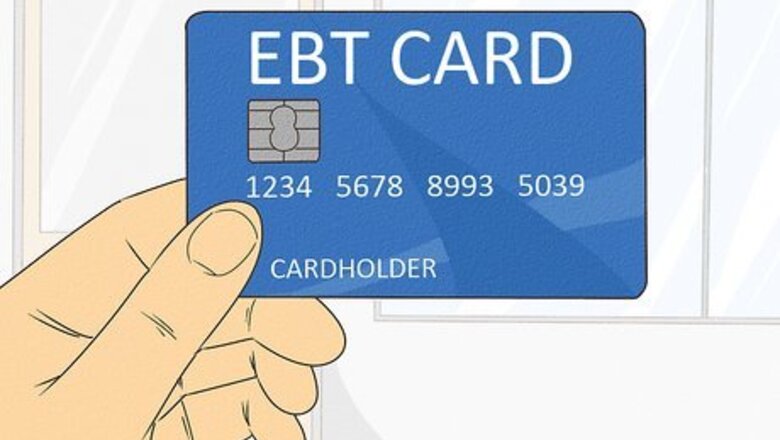
views
Looking into Government Assistance

See if you qualify for the Supplemental Nutrition Assistant Program (SNAP). The Supplemental Nutrition Assistant Program, or SNAP, provides you with an electronic card that you can use at grocery stores to buy food. SNAP cards are known as Electronic Benefits Transfer Card, or an EBT card. Not all grocery store purchases can be made using a EBT card. You can only use your card to purchase food or seeds to grow food to eat. Household items, alcoholic beverages, tobacco, vitamins, minerals, and hot foods cannot be purchased with an EBT card. To qualify for SNAP, you can have no more than $2, 250 in countable resources or no more than $3,250 in countable resources if at least one person in the household is over 60 or disabled. Countable resources include things like a bank account. Resources like a home or lot are not counted. The monthly income cut off to be eligible for SNAP is dependent on the size of your household. You can find a listing of income cutoffs by looking up the SNAP program on the United States Department of Food and Nutrition Service's website. In some states, farmers will match SNAP dollars at markets. For example, $1 in SNAP money will buy $2 in produce.
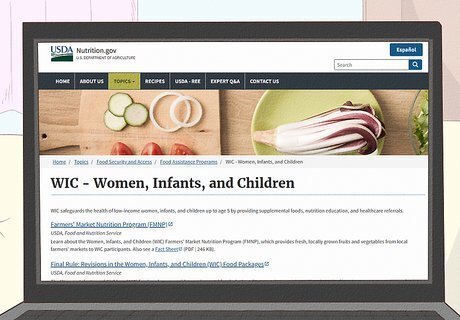
Look into food assistance programs for parents. Certain government assistance programs are directed specifically towards families with children. If you have young children, you might want to consider one of these programs. The Women, Infants, and Children Program, or WIC, provides benefits to such as food, nutrition, and education to low income pregnant, breastfeeding, and postpartum women as well as infants and children up to the age of 5 who are at nutrition risk. WIC is available in all 50 states. To qualify for WIC you must meet income guidelines, state residency requirements, and be declared at nutritional risk by a physician. Income requirements once again depend on family size and specifics can be found on the Department of Food and Nutrition Service's website. Qualifications for nutrition risk include medically-based risk, like a history of pregnancy complications or a condition like anemia, and dietary risks, such as inability to meet current dietary guidelines. The government also has a variety of child nutrition programs designed to assure children have access to food. School lunches are offered in many schools, and offered at a free or discount rate for low-income families. The Child and Adult Food Care Program offers free, healthy foods to children in daycare centers, after school programs, and emergency shelters. Other programs, such as summer food programs or free breakfast programs, are also available for qualifying households.

Check qualifications for senior nutrition programs. If you are a senior, there are a variety of senior specific programs you might qualify to receive free or discount foods. The Elderly Nutrition Program provides home delivered meals to homebound elderly patients or disabled people under the age of 60. You must be at significant physical or economic disadvantage to qualify. Check with the Department of Food and Nutrition Service's website to see if you qualify. The National Food Incentive Program (NFIP) distribute healthy foods to the elderly. Qualifications vary based on stage, age, and occupation. Check with the Department of Food and Nutrition.
Finding Cheap or Free Foods
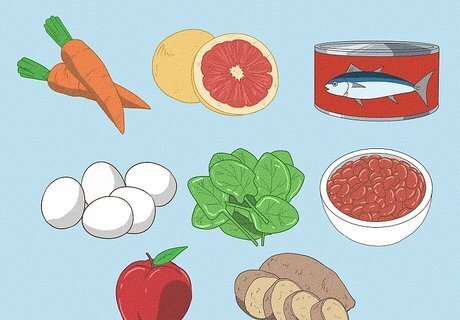
Familiarize yourself with cheap, healthy foods. There are many healthy foods that are available for purchase at a low cost and can be used in a variety of meals or as snacks. Familiarize yourself with healthy, affordable options. As far as produce, grapefruit, carrots, spinach, and sweet potato usually go for no more than $1-$4 at most supermarkets. Grapefruits can serve as a good addition to breakfast, apples and carrots can be used as snacks, spinach can be added to sandwiches or salads, and sweet potatoes can be fried, grilled, or baked as a side dish to many meals. Eggs are an excellent low cost option when it comes to saving money on food. A dozen eggs is usually less than $5. Eggs are a great source of lean protein and contain vitamin B12. They can be prepared a variety of ways, providing you with a diversity of meals at a low cost. Canned tuna sells for less than a dollar at most supermarkets. Tuna, like eggs, is a good source of lean protein and can be added to casseroles, salads, and sandwiches. Beans, whether canned or bagged, are a healthy legume that contain fiber and many vitamins and minerals. If you're vegetarian or vegan, beans are a good source of protein. Beans can be used in salads, stews, or burritos. You can also eat beans as a side dish or a meal.

Download a copy of Good and Cheap. Food studies scholar Leanne Brown discovered when getting her master's from New York University that many people on government assistance eat too many processed foods. To combat this trend, she wrote a cookbook, Good and Cheap, that is available for free online. Good and Cheap outlines how to stock your pantries with cheap staples that can be used to create a variety of meals. Brown also encourages flexibility in terms of meals, offering a variety of alternative ingredients for each recipe. She encourages experimentation, especially with produce as costs of fruits and veggies fluctuate by season. Brown also suggests ways to use leftovers to make new meals and how to liven up snacks with the addition of spices.

Seek out food banks and food pantries. If you are struggling to pay for food due to a low income or unemployment, food banks and food pantries are available nationwide to provide free food. FreeFood.org is a great website for locating food banks and pantries in your area. You simply enter your zip code and a variety of options will display on the screen. Food banks usually provide cooked meals to the homeless or very low income families. Food banks tend to be found at churches or community centers, but are also sometimes run out of a truck or cart. Some colleges and universities also run food banks. Campus Kitchen is a program that repurposes food that is about to expire to cook and deliver to low income families. You can check for Campus Kitchen locations in your area using their website. Food pantries usually provided donated food, such as canned goods and breads, for free or cheap to low income families or the homeless. Remember, these options are not merely for people trying to cut back on spending. Food banks and pantries are designed to help people with legitimate financial struggles due to unemployment or low wages or people who are between homes. If you're simply trying to save money, go for a different option.
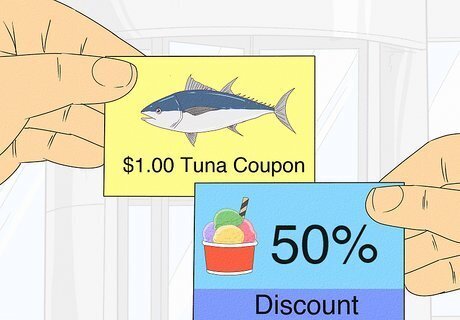
Get coupons. Coupons can be a great resource when it comes to finding cheap food. Be on the lookout for coupons, especially those specific to your dietary needs and preferences. When using coupons, try to use them on sale items unless the coupon specifically says it can only be used on full priced items. Use your $1.00 tuna coupon to buy tuna that's already 2 for 1, for example. Do not be picky about brands when using coupons. Try to always select the brand that is on sale or has the best coupon deal. Even if you love Skippy Peanut Butter, you can live with Jif if you have a 50% off coupon. To maximize the savings on coupons, only clip or print coupons for food items you know you'll buy and use. Go to the store with a specific list and do not deviate. Oftentimes, people get dazzled by new deals advertised in stores but oftentimes the savings aren't that big. This can result in you getting tricked into buying a name brand food item that's more expensive than the store brand even with the sales price. Some stores, such as Publix, allow you to stack manufacturer and store coupons, so if you have two $1.00 off coupons you can use both on the same item. Some stores also accept competitor store coupons. Ask about their policies at the register.
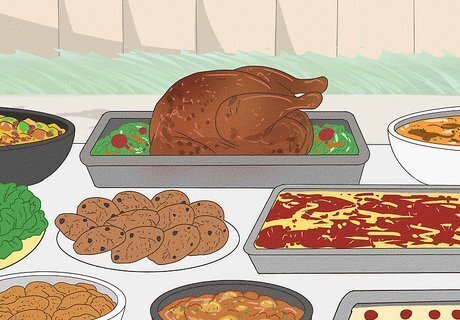
Throw community potlucks. Consider starting up a potluck in your community, in which everyone can bring a small dish. Even if you can't afford to make a big meal, a simple casserole made from cheap ingredients can serve well as a side dish. Collaborate with other friends or community members you know are also on a budget. They might be interested in doing regular potluck nights a few times a week so everyone saves money. Families with small children might be particularly interested in a regular community potluck as this saves them the time and money of cooking for the night.

Shop at discount grocery stores. If you can find a discount grocery store in your area, try to shop there. Discount stores buy things like dented cans, overstocked foods, and other items regular retailers might not shelve and sell them for a reduced rate. Be careful with dented cans. Know the protocol about when it is and is not safe to buy a dented can. A can with a dent in the seam, a dent where the sides and ends of a can meet, a sharp dent, or a dent that causes bulging of swelling means the can is probably not safe for consumption. Dents at the top of a can are also a bad sign. This means the seal could have broken, allowing harmful bacteria to get inside the can.
Foraging for Food

Grow your own food. If possible, you could grow certain food items on your own. If you have the time and resources to grow food, this could save some money on the cost of produce. Even if you do not have a backyard, certain fruit, vegetables, and legume plants can grow healthily out of pots. Beans, corn, carrots, radishes, spinach, and others can be grown from a pot. Make sure the soil is watered regularly. Water it once a day or whenever it feels damp. You will need to provide your plants light, however. If you do not have access to a lot of natural light via windows or a balcony, many greenhouses and hardware stores sell grow lights that simulate the effect of natural sunlight. If growing your own food is not possible, look into community garden projects in your city. If you get involved, you might be eligible to receive free items from each harvest. Community gardens also might allow you a specific plot where you can grow and tend to your own fruits and vegetables.
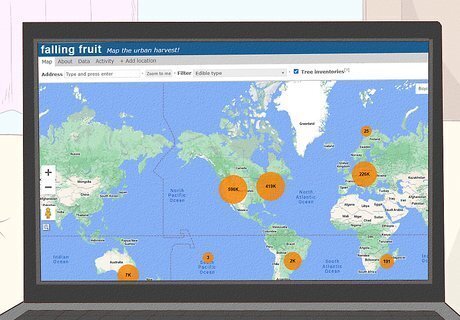
Seek out edible plants in your area. Oftentimes, certain spots in a city or town contain fruit trees or edible plants. If the area is a community space, it is legal for you to pick the fruit and greens for your own consumption. If you're not sure where to get started, the website Falling Fruit provides an interactive map of a variety of cities. Falling Fruit locates areas where food grows and is legal to forage. Using Falling Fruit, you could potentially find free, fresh produce. Scope your community when you go out and be on the lookout for apple trees, peach trees, and other edible plants. Ask around if you discover, say, an apple tree to make sure it falls on community rather than private property. If you pick apples from a tree found on someone's personal residence, you could potentially get in legal trouble. Buy a foraging handbook. These are guides that will help you differentiate between plant types to know what's safe to eat. It will also teaching you how to properly clean and store foraged food. Dumpster diving is a type of foraging where people go to the dumpsters of groceries stores and restaurants to search for recently expired food that's been thrown out. Careful though. Dumpster diving is not always legal and if there are posted signs prohibiting trespassing it's best to go elsewhere. Some areas have outright banned dumpster diving, so check the regulations in your area. Also, only take food from dumpsters if it's in a safe plastic wrapping that is unbroken or otherwise damaged.
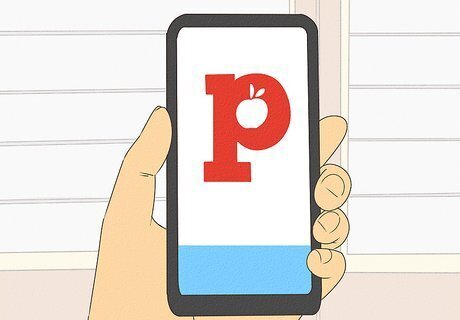
Use PareUp to find legally buy leftover grocery food. PareUp is an application that allows groceries stores to sell surplus food at a discount price rather than throwing it out. You can download PareUp using your smart phone. Groceries stores enter their excess food into PareUp's inventory, alongside its time of availability and price. If you see a food item you'd be interested in purchasing, you can claim it using PareUp and then go pick it up at your convenience.


















Comments
0 comment